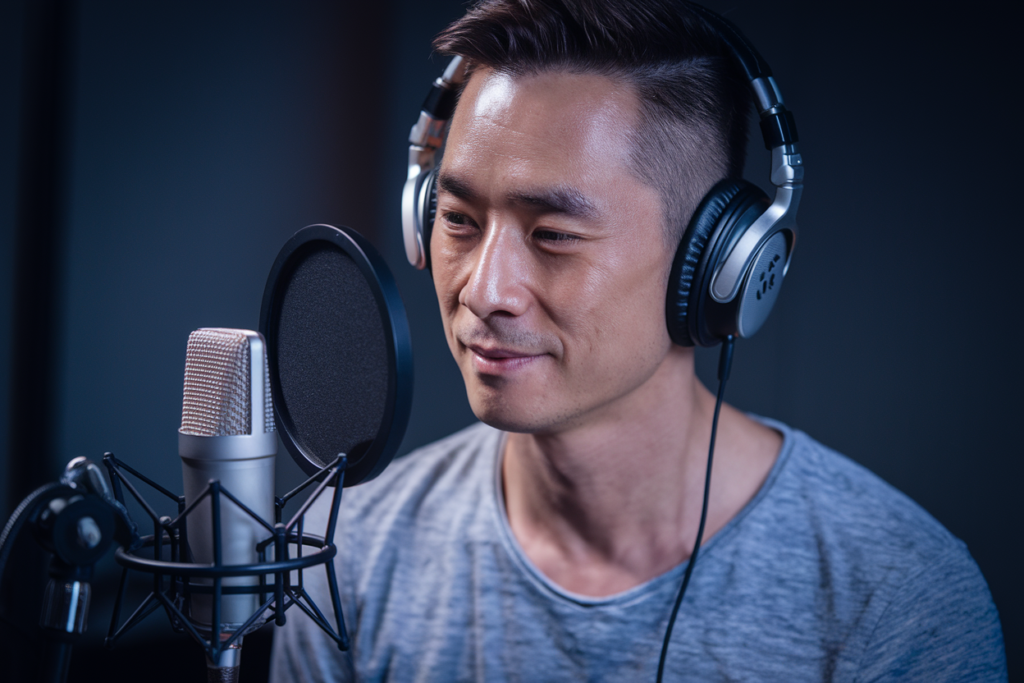Key Takeaways
- Cultural Awareness is Key: Understanding cultural nuances and emotional expressions specific to Chinese culture enhances voice actors’ ability to connect with characters authentically.
- Address Language Barriers: Targeted coaching that focuses on diction and pronunciation helps voice actors overcome language challenges, ensuring clarity and natural delivery.
- Emotional Modulation Matters: Techniques like voice modulation allow actors to adjust their pitch and tone based on character emotions, significantly improving performance quality.
- Character Development Enhances Performance: Analyzing scripts and building character backstories are essential for voice actors to portray characters authentically and engage listeners effectively.
- Utilize Quality Tools: Investing in recording equipment, software applications, and training materials can enhance the coaching experience for both coaches and voice talent.
- Continuous Learning is Essential: Engaging with online resources such as webinars, workshops, and tutorial videos fosters growth in techniques relevant to the evolving landscape of voice acting.
Ever wondered how to elevate the performances of Chinese voice actors? Coaching Chinese voice actors for better delivery isn’t just about technique; it’s about unlocking their unique potential. In a world where storytelling transcends borders, effective vocal delivery can make or break a character’s impact.
Imagine your favorite animated film or video game—what if the voices didn’t resonate as they should? That’s where targeted coaching comes in. By focusing on cultural nuances and emotional expression, you can help these talented individuals connect deeply with their audience. Whether you’re a director looking to enhance your cast’s performance or an aspiring coach yourself, mastering this art is key to creating unforgettable characters that truly come alive.
Overview of Coaching Chinese Voice Actors
Coaching Chinese voice actors focuses on enhancing their delivery and ensuring they resonate with audiences. Vocal performance plays a vital role in storytelling, especially in animated films and video games. With the right guidance, voice artists can unlock their true potential.
Effective coaching involves understanding cultural nuances that influence emotional expression. This awareness allows voice actors to connect authentically with characters and narratives. For instance, a skilled coach helps them explore tonal variations and inflections unique to Mandarin or Cantonese dialects.
Targeted training emphasizes techniques that improve clarity and projection. It also cultivates flexibility in adapting to various roles, from animated characters to commercial spots. Coaches often employ exercises tailored to enhance breath control, diction, and emotive range.
Engaging with the material is crucial for voice talent development. Encouraging experimentation with different styles empowers actors to discover their strengths while refining areas needing improvement. Regular feedback ensures continuous growth and confidence in their performances.
Ultimately, effective coaching transforms aspiring voiceover professionals into compelling storytellers who captivate listeners through dynamic vocal delivery.
Key Challenges in Voice Acting
Voice acting presents unique challenges that can impact the delivery of performances. Recognizing these hurdles is essential for coaches and voice actors aiming to enhance their skills.
Cultural Nuances
Cultural nuances play a vital role in voice acting, especially for Chinese voice actors. Understanding cultural references, idioms, and emotional expressions specific to Chinese culture helps voice artists create authentic connections with characters. Coaches should guide voice talent in exploring local dialects, slang, and social contexts to enrich their performances. For instance, subtle variations in tone can convey different meanings or emotions based on cultural backgrounds. Engaging with these nuances allows voice actors to resonate more deeply with audiences.
Language Barriers
Language barriers often pose significant challenges for non-native speakers in the voiceover industry. Fluency doesn’t guarantee effective vocal performance; it’s about expressing emotions authentically through language. Voice actors may struggle with pronunciation or intonation that differs from their native language patterns. Targeted coaching focuses on diction exercises that help improve clarity and projection in Mandarin or other languages used in projects. Practicing difficult phrases repeatedly ensures better confidence during recordings, allowing for a more natural delivery that captivates listeners.
By addressing these key challenges—cultural nuances and language barriers—coaches empower voice actors to elevate their craft, ultimately transforming their performances into compelling storytelling experiences.
Techniques for Effective Coaching
Coaching Chinese voice actors involves a variety of techniques that enhance their vocal delivery and connect them more deeply with the material. These methods ensure that voice talent can effectively express emotions and convey narratives.
Voice Modulation
Voice modulation is crucial for creating engaging performances. It allows voice actors to adjust pitch, tone, and volume based on character emotions or scene dynamics. Encourage your voice artists to practice varying their tones; using higher pitches for excitement and lower ones for seriousness can significantly elevate a performance. Incorporating exercises like reading dialogues with different emotional contexts helps develop this skill. Suggest they record themselves to review how modulation affects delivery, making adjustments as needed.
Emotional Delivery
Emotional delivery is vital in storytelling through voiceovers. It’s not just about the words spoken but how they’re conveyed. Help your voice actors tap into their emotional range by connecting personal experiences to character feelings. Use role-playing scenarios where they must evoke specific emotions—joy, sadness, anger—to create authentic responses. This technique fosters a deeper connection between the performer and the narrative, allowing listeners to feel invested in the story being told.
When coaching these aspects of performance, remember that practice makes perfect; consistent rehearsal builds confidence in delivering compelling vocal performances.
Understanding Character Development
Character development forms the backbone of a compelling voiceover performance. By diving deep into the essence of each character, you can create authentic and engaging narratives that resonate with audiences.
Analyzing Scripts
Analyzing scripts is essential for voice actors aiming to elevate their delivery. When you dissect a script, look for key elements like tone, emotion, and context. What’s the character’s motivation? How do they feel in specific scenes? Understanding these aspects allows you to embody your character authentically. You might consider highlighting emotional cues or shifts in dialogue that signal changes in mood or intent. This attention to detail ensures that your performance captures the nuances of storytelling effectively.
Building Character Backstories
Building character backstories enriches your portrayal as a voice actor. A well-crafted backstory provides insights into a character’s motivations, fears, and desires. Think about questions like: Where did this character come from? What experiences shaped them? By answering these questions, you create depth in your performance. Incorporate personal anecdotes or relatable emotions to connect with the audience on a deeper level. This connection transforms mere words into powerful storytelling moments that leave lasting impressions.
Embrace these techniques to refine your craft as a voice talent and deliver performances that truly resonate with listeners.
Tools and Resources for Coaches
Coaching Chinese voice actors requires a variety of tools and resources to enhance their delivery and performance. Here are some essential items that can elevate your coaching sessions:
Recording Equipment
- Quality Microphone: A professional-grade microphone captures clear audio, essential for voiceovers.
- Audio Interface: This device connects the microphone to a computer, improving sound quality during recordings.
- Headphones: Closed-back headphones help monitor recordings without bleed, allowing for precise adjustments.
Software Applications
- Digital Audio Workstation (DAW): Programs like Audacity or Adobe Audition enable editing and mixing of voice tracks effectively.
- Voice Analysis Tools: Software that analyzes pitch, tone, and volume provides valuable feedback on vocal delivery.
Training Materials
- Scripts: Diverse scripts expose voice actors to different styles, tones, and emotions necessary for various projects.
- Exercises: Structured exercises focusing on articulation, breath control, and emotional expression help build foundational skills.
Online Resources
- Webinars & Workshops: Participate in industry-related online events to stay updated on trends in voice acting techniques.
- Tutorial Videos: Platforms like YouTube offer instructional content from experienced professionals that can inspire new methods.
Networking Platforms
- Social Media Groups: Engage with communities where coaches share insights about overcoming common challenges faced by voice talents.
- Forums & Discussion Boards: These platforms allow you to ask questions and receive advice from seasoned coaches and voice artists alike.
Utilizing these tools not only enhances the coaching experience but also empowers Chinese voice actors to refine their skills. With the right resources at hand, you foster an environment conducive to growth—one where each actor can explore their unique potential in delivering captivating performances.
Conclusion
Coaching Chinese voice actors is essential for creating impactful performances that resonate with audiences. By focusing on cultural nuances and emotional depth you can help them embrace their unique storytelling potential.
Employing tailored techniques like voice modulation and character analysis encourages authenticity in their delivery. As a coach your role is to foster an environment where experimentation thrives enabling continuous growth and confidence among voice artists.
With the right tools and resources at your disposal you’ll empower these performers to elevate their craft. Ultimately this commitment to coaching not only enhances individual talent but also enriches the overall narrative experience in animated films and video games.
Frequently Asked Questions
What is the significance of coaching for Chinese voice actors?
Coaching helps Chinese voice actors improve their vocal delivery and connect with characters more authentically. It focuses on cultural nuances, emotional expression, and specific techniques to enhance their performance.
How do cultural nuances impact voice acting in China?
Cultural nuances, such as local dialects and idioms, play a crucial role in creating authentic connections between voice actors and their characters. Understanding these elements allows for more relatable performances.
What techniques are essential for effective vocal coaching?
Key techniques include tonal variations, clarity, projection, and flexibility. Tailored exercises help enhance breath control, diction, and emotive range to improve overall vocal performance.
Why is emotional delivery important in storytelling?
Emotional delivery enriches storytelling by allowing voice actors to convey the depth of their characters’ feelings. Techniques like role-playing can help evoke specific emotions that resonate with the audience.
How can character development enhance voiceover performances?
Analyzing scripts for tone, emotion, and motivation helps voice actors embody their characters convincingly. Building character backstories adds depth and relatability to performances.
What tools should coaches use when training voice actors?
Coaches should utilize quality recording equipment like professional microphones and audio interfaces. Additionally, software applications for editing and feedback can significantly enhance training sessions.
Where can coaches find resources for improving their skills?
Coaches can access online resources such as webinars, tutorial videos, and networking platforms to stay updated on industry trends while fostering community engagement among peers.







